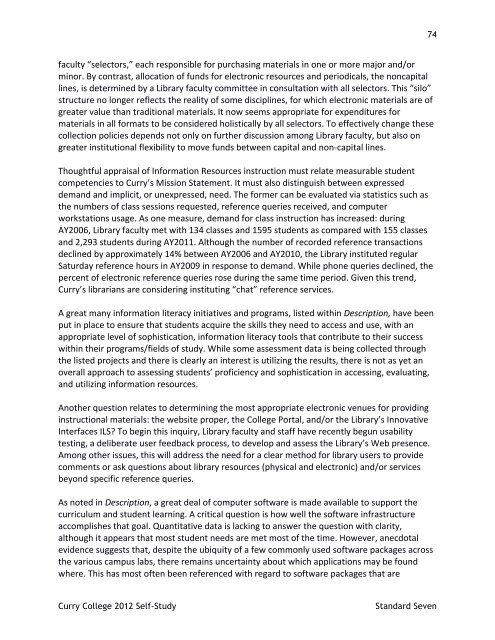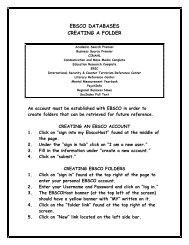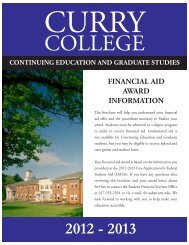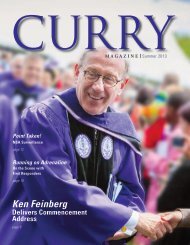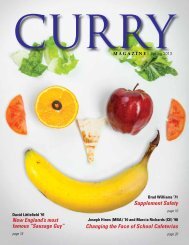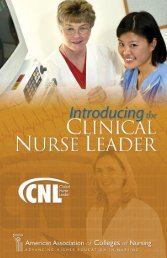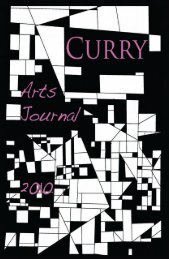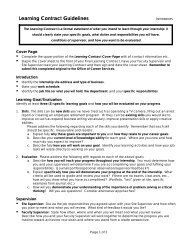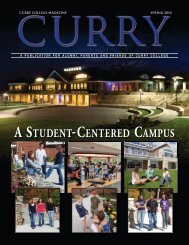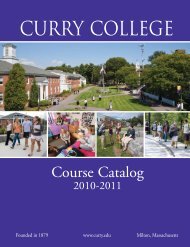Read the Curry College NEASC 2012 Self-Study Report.
Read the Curry College NEASC 2012 Self-Study Report.
Read the Curry College NEASC 2012 Self-Study Report.
You also want an ePaper? Increase the reach of your titles
YUMPU automatically turns print PDFs into web optimized ePapers that Google loves.
74<br />
faculty “selectors,” each responsible for purchasing materials in one or more major and/or<br />
minor. By contrast, allocation of funds for electronic resources and periodicals, <strong>the</strong> noncapital<br />
lines, is determined by a Library faculty committee in consultation with all selectors. This “silo”<br />
structure no longer reflects <strong>the</strong> reality of some disciplines, for which electronic materials are of<br />
greater value than traditional materials. It now seems appropriate for expenditures for<br />
materials in all formats to be considered holistically by all selectors. To effectively change <strong>the</strong>se<br />
collection policies depends not only on fur<strong>the</strong>r discussion among Library faculty, but also on<br />
greater institutional flexibility to move funds between capital and non‐capital lines.<br />
Thoughtful appraisal of Information Resources instruction must relate measurable student<br />
competencies to <strong>Curry</strong>’s Mission Statement. It must also distinguish between expressed<br />
demand and implicit, or unexpressed, need. The former can be evaluated via statistics such as<br />
<strong>the</strong> numbers of class sessions requested, reference queries received, and computer<br />
workstations usage. As one measure, demand for class instruction has increased: during<br />
AY2006, Library faculty met with 134 classes and 1595 students as compared with 155 classes<br />
and 2,293 students during AY2011. Although <strong>the</strong> number of recorded reference transactions<br />
declined by approximately 14% between AY2006 and AY2010, <strong>the</strong> Library instituted regular<br />
Saturday reference hours in AY2009 in response to demand. While phone queries declined, <strong>the</strong><br />
percent of electronic reference queries rose during <strong>the</strong> same time period. Given this trend,<br />
<strong>Curry</strong>’s librarians are considering instituting “chat” reference services.<br />
A great many information literacy initiatives and programs, listed within Description, have been<br />
put in place to ensure that students acquire <strong>the</strong> skills <strong>the</strong>y need to access and use, with an<br />
appropriate level of sophistication, information literacy tools that contribute to <strong>the</strong>ir success<br />
within <strong>the</strong>ir programs/fields of study. While some assessment data is being collected through<br />
<strong>the</strong> listed projects and <strong>the</strong>re is clearly an interest is utilizing <strong>the</strong> results, <strong>the</strong>re is not as yet an<br />
overall approach to assessing students’ proficiency and sophistication in accessing, evaluating,<br />
and utilizing information resources.<br />
Ano<strong>the</strong>r question relates to determining <strong>the</strong> most appropriate electronic venues for providing<br />
instructional materials: <strong>the</strong> website proper, <strong>the</strong> <strong>College</strong> Portal, and/or <strong>the</strong> Library’s Innovative<br />
Interfaces ILS To begin this inquiry, Library faculty and staff have recently begun usability<br />
testing, a deliberate user feedback process, to develop and assess <strong>the</strong> Library’s Web presence.<br />
Among o<strong>the</strong>r issues, this will address <strong>the</strong> need for a clear method for library users to provide<br />
comments or ask questions about library resources (physical and electronic) and/or services<br />
beyond specific reference queries.<br />
As noted in Description, a great deal of computer software is made available to support <strong>the</strong><br />
curriculum and student learning. A critical question is how well <strong>the</strong> software infrastructure<br />
accomplishes that goal. Quantitative data is lacking to answer <strong>the</strong> question with clarity,<br />
although it appears that most student needs are met most of <strong>the</strong> time. However, anecdotal<br />
evidence suggests that, despite <strong>the</strong> ubiquity of a few commonly used software packages across<br />
<strong>the</strong> various campus labs, <strong>the</strong>re remains uncertainty about which applications may be found<br />
where. This has most often been referenced with regard to software packages that are<br />
<strong>Curry</strong> <strong>College</strong> <strong>2012</strong> <strong>Self</strong>-<strong>Study</strong><br />
Standard Seven


